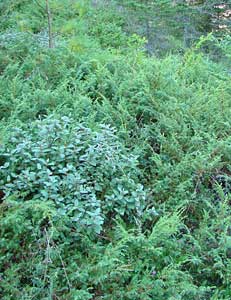Elaeagnaceae: Shepherdia canadensis (L.) Nutt.
(soapberry, Canadian buffaloberry, soopolallie )
Soapberry is a deciduous shrub growing up to 4 m height. It has opposite, dark green, leathery leaves with silvery-whitish hairs on the undersurface. The branches, twigs and undersides of leaves are pocked with rusty-colored spots or "scales". Small yellowish-green flowers appear in spring just before the leaves come out. The species is dioecious. Red, berry-like fruits are produced on the female plants.
Soapberry grows on coarse soils subject to periodic drying. It has nodules on the roots that fix nitrogen which enables the species to grow on nutrient poor soils. In Nova Scotia, Roland and Smith describe soapberry as distributed "locally but usually abundant where found", noting its occurrence on gypsum in Hant's Co., on gypsum or talus slopes in northern Cape Breton, and "along the coast within reach of salt spray."1
Sources | Notes & Refs | Selected Web Resources | Line Drawing
Click on images for larger versions.
|
Aug.1, 2007. Hants County: Avon Peninsula, on gypsum karst close to the Beaver Pond in the forested upland. Photographer: JackPine. Notes |
|

Sheperdia amongst Juniper communis. |
 Developing fruits. |

|
Selected Web Resources
- Taxonomic Status (ITIS) Copy the species name above and paste it into a form on this ITIS Canada page to confirm the nomenclature and list synonyms.
- NatureServe Explorer Copy the species name above and paste it into a form on this page to view a map of its distribution within North America and its conservation status by province and state.
- Fire Effects Information System Referenced overview of botanical and ecological characteristics, fire ecology, managment.
- Soopolallie (Shepherdia canadensis) (PDF Document) Page on the web site of the British Columbia Ministry of Forests and Range, Southern Interior Forest Range, with some information on the use of soapberry for food and medicine by First Nationas People.
Notes & References
- Roland, A.E and E.C. Smith. 1969. The flora of Nova Scotia. The Nova Scotia Museum, Halifax, Nova Scotia.